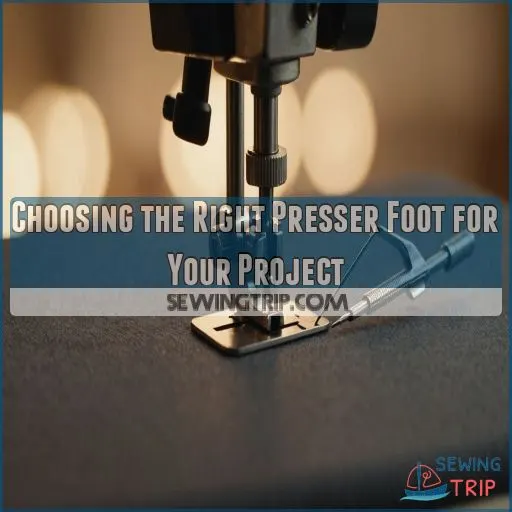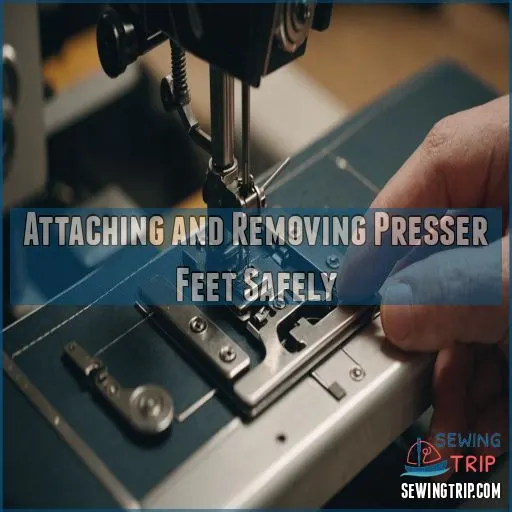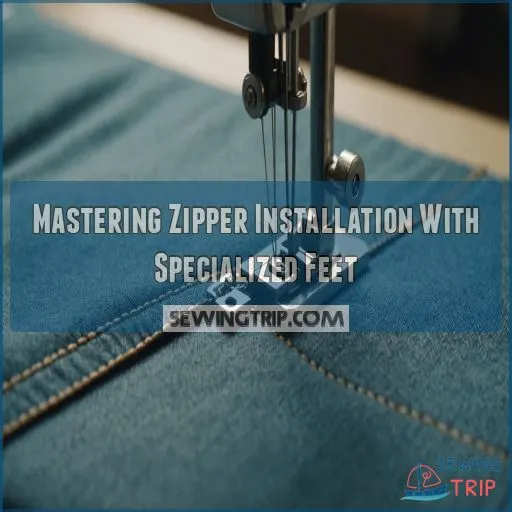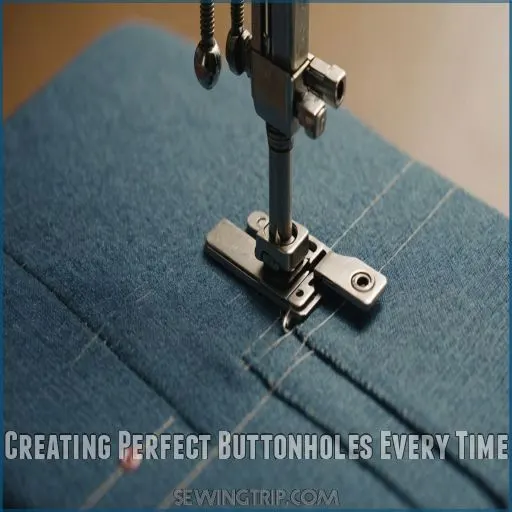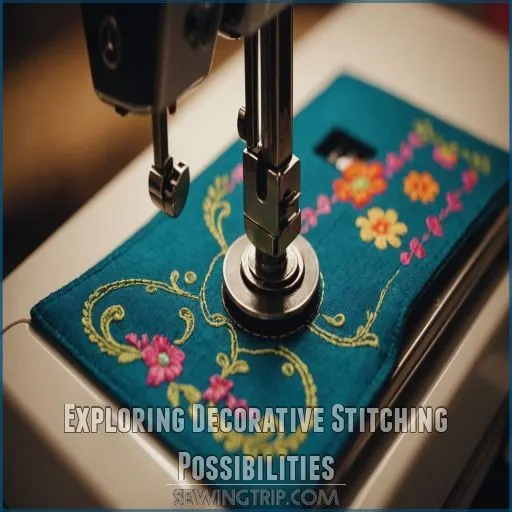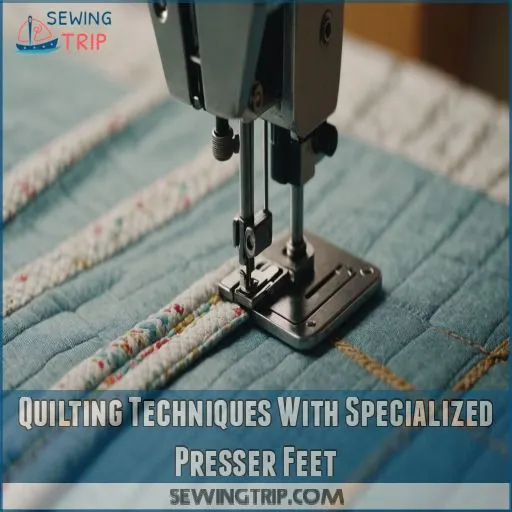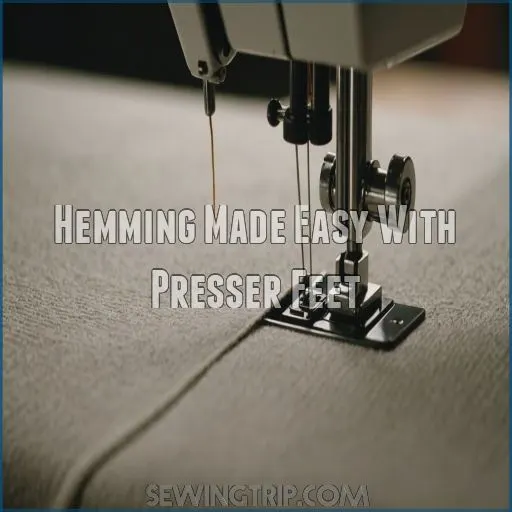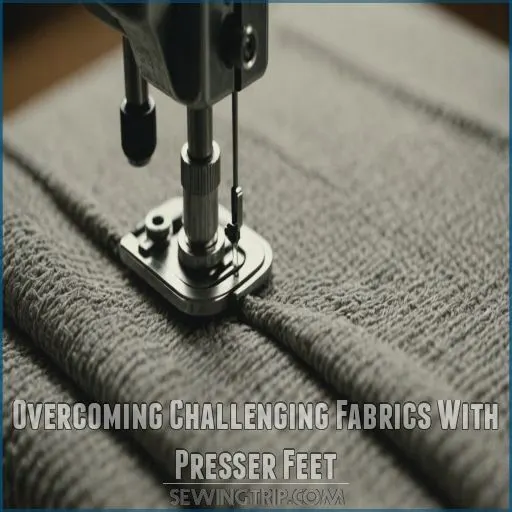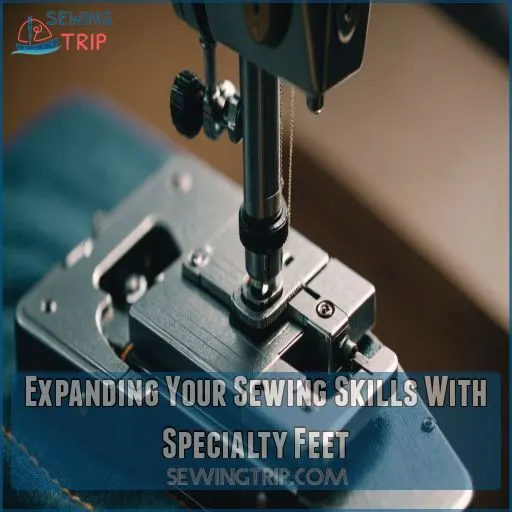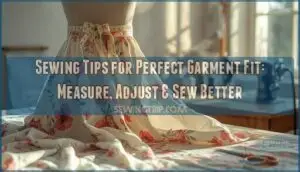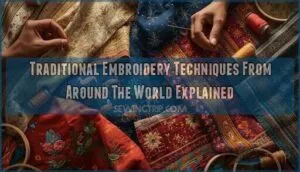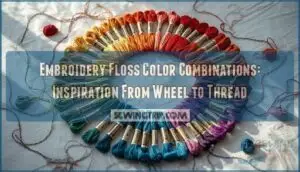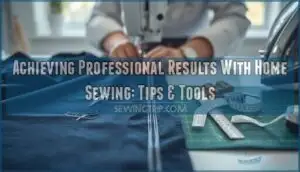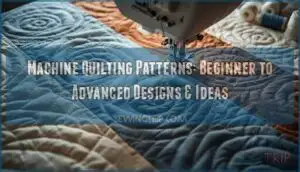This site is supported by our readers. We may earn a commission, at no cost to you, if you purchase through links.
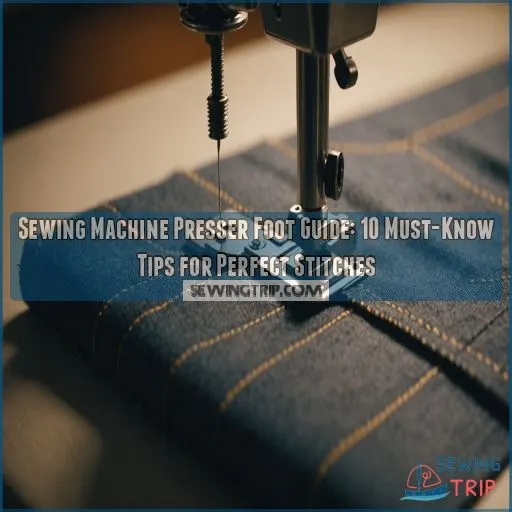 Your sewing machine presser foot guide is like a Swiss Army knife for your fabric adventures.
Your sewing machine presser foot guide is like a Swiss Army knife for your fabric adventures.
From zippy zipper feet to buttonhole wizards, these attachments are your ticket to stitching success.
You’ll want to match your foot to your fabric and project – think non-stick for vinyl or walking foot for quilts.
Swapping feet is a breeze once you get the hang of it, just remember to power down first (nobody likes a surprise finger!).
Mastering these little helpers opens up a world of creative possibilities, from perfect buttonholes to fancy decorative stitches.
And here’s a little secret: the right foot can make even tricky fabrics behave like well-trained pets.
Table Of Contents
- Key Takeaways
- Types of Sewing Machine Presser Feet
- Choosing the Right Presser Foot for Your Project
- Attaching and Removing Presser Feet Safely
- Mastering Zipper Installation With Specialized Feet
- Creating Perfect Buttonholes Every Time
- Exploring Decorative Stitching Possibilities
- Quilting Techniques With Specialized Presser Feet
- Hemming Made Easy With Presser Feet
- Overcoming Challenging Fabrics With Presser Feet
- Expanding Your Sewing Skills With Specialty Feet
- Frequently Asked Questions (FAQs)
- Conclusion
Key Takeaways
- Choose the Right Foot for Your Fabric: Picking the perfect presser foot is like finding the right dance partner. For slippery fabrics, a walking foot keeps everything in line, while a Teflon foot is your best buddy for sticky surfaces, such as vinyl and leather.
- Mastering Foot Swaps: Don’t let changing presser feet feel like defusing a bomb. With a little practice, you’ll be switching from a zigzag to a zipper foot as smoothly as flipping channels on TV. Just remember: machine off first—no surprise pinches!
- Creative Possibilities Await: Each presser foot is like a superhero with its own power. From making invisible hems with a blind hem foot to decorating with a satin stitch foot, there’s a whole world of sewing magic waiting for you. It’s time to let your project ideas soar!
- Regular Maintenance is Key: Keep your presser feet happy and your projects smooth by giving them a regular clean. A quick brush and some TLC will prevent rust and ensure your machine runs like a dream. Let’s face it: a contented presser foot equals a contented sewer!
Types of Sewing Machine Presser Feet
You’ll be amazed at how many different sewing machine presser feet there are for your sewing machine
.
Each one’s like a tiny superhero with its own special power.
From the trusty straight stitch foot to the fancy buttonhole maker, these little gadgets will transform your sewing game and help you tackle any project with ease.
Straight Stitch Foot
Ready to tame your sewing machine? Meet the straight stitch foot, your new best friend for precise stitching.
This workhorse keeps your fabric flat and feeds it evenly, perfect for quilting and topstitching. You’ll love the scant 1/4" seam it delivers – a game-changer for quilters.
Struggling with thick fabrics? Try the flex reaction straight stitch foot for smooth sailing over bulky seams. It’s like having a tiny, tireless assistant right under your needle!
Zigzag Foot
The versatile zigzag foot is your trusty sidekick for a variety of stitches.
It’s not just for zigzags – you’ll use it for straight stitches, decorative patterns, and even basic overcasting.
Think of it as the Swiss Army knife of presser feet.
For knit fabrics, it’s a game-changer. Just remember, while it’s great for beginners, some tricky fabrics might give you a run for your money.
Zipper Foot
Now that you’ve mastered the zigzag, let’s zip into zipper feet. These nifty attachments are your ticket to smooth, professional-looking closures.
- Regular zipper foot: Gets you up close and personal with those teeth
- Invisible zipper foot: For those "now you see it, now you don’t" moments
- Adjustable zipper foot: Like a chameleon, it adapts to your needs
- Piping foot: Doubles as a zipper foot for extra versatility
Buttonhole Foot
Say goodbye to zipper woes and hello to buttonhole bliss! Your buttonhole foot is about to become your new best friend. This nifty attachment turns a tricky task into a breeze, creating perfect buttonholes every time.
Let’s explore how this foot can revolutionize your sewing game:
| Emotion | Buttonhole Experience |
|---|---|
| Joy | Effortless precision |
| Relief | No more guesswork |
| Pride | Professional results |
| Excitement | Endless possibilities |
With various types and sizes available, you’ll find the perfect fit for any project.
Blind Hem Foot
You’ve mastered buttonholes, now let’s tackle invisible hems!
The blind hem foot is your secret weapon for professional-looking finishes.
With its metal guide, you’ll create stitches that are barely visible on the right side of your fabric . It’s like magic for hemming pants or skirts!
Just fold your fabric, and watch as your machine takes tiny bites, creating a nearly invisible hem.
You’ll be hemming like a pro in no time!
Overcast Foot
While the blind hem foot keeps your stitches hidden, the overcast foot is your secret weapon against fraying edges.
This little marvel wraps thread around your fabric’s edge, giving you a serger-like finish without breaking the bank.
Simply clip it on, line up your fabric, and watch the magic happen.
It’s like giving your seams a protective hug – no more unraveling nightmares!
Walking Foot
Ever feel like you’re wrestling an unruly fabric sandwich? Enter the walking foot, your secret weapon for taming thick materials and multiple layers.
This nifty attachment adds an extra set of feed dogs on top, ensuring even fabric feed and preventing puckering . It’s a quilter’s best friend, perfect for straight-line stitching and handling slippery fabrics.
Whether you’re rocking a low or high shank machine, this foot’s got your back!
Darning Foot
The darning foot is your ticket to sewing machine magic!
This versatile attachment lets you mend tears, create free-motion embroidery, and even dabble in thread painting.
It’s like having a magic wand for fabric repair.
Drop those feed dogs, and you’re free to move in any direction.
Ready to tap into your inner artist?
This foot’s your new best friend for stitching outside the lines and is your key to sewing machine magic!
Choosing the Right Presser Foot for Your Project
You’re ready to sew, but wait—have you picked the right presser foot for your project?
Choosing the perfect presser foot can make or break your stitching.
Let’s explore how to match your foot to your fabric, stitch pattern, and sewing goals.
Fabric Type Considerations
Now that you’re armed with knowledge about different presser feet, let’s talk fabric! Choosing the right foot for your material can make or break your project. It’s like picking the perfect dance partner – you want a smooth tango, not a clumsy two-step!
- Slippery fabrics: Grab a walking foot to keep layers in line
- Knits: A roller foot‘s your best friend to prevent stretching
- Leather or vinyl: Teflon foot glides like butter
- Fraying fabrics: Overlock foot finishes edges beautifully
- Shiny or satin: Satin stitch foot for a flawless sheen
Stitch Pattern Requirements
Choosing the right presser foot isn’t just about fabric – it’s about matching your stitch pattern too. You’ll need to think about stitch length, width, and type.
For those fancy satin stitches, you’ll want an open-toe foot to see what you’re doing.
Thinking about edge stitching? Grab that edge stitch foot for picture-perfect results.
Remember, the right foot can turn your sewing from "meh" to "marvelous" faster than you can say "bobbin"!
Special Techniques and Effects
Ready to jazz up your sewing projects? Let’s explore special techniques that’ll make your creations pop.
For free-motion embroidery, swap in a darning foot to get creative . Whip out your braiding foot for eye-catching trims, or use a cording foot to add dimension.
Want to gather like a pro? The gathering foot‘s your new best friend.
And don’t forget the appliqué stitch foot for seamless fabric layering.
Ease of Use for Beginners
Let’s talk beginner-friendly feet.
You’ve learned some fancy footwork, but don’t get your threads in a tangle. Start with an essential foot kit.
The all-star zigzag foot, your new BFF , is like training wheels for your sewing journey.
Remember, foot compatibility is key – check your machine’s manual. Avoid common foot mistakes by mastering basic uses first.
You’ll be a sewing machine foot encyclopedia in no time!
Attaching and Removing Presser Feet Safely
Swapping presser feet on your sewing machine doesn’t have to feel like defusing a bomb.
With a few simple tricks up your sleeve, you’ll be snapping and unscrewing those feet like a pro, keeping your fingers safe and your projects on track, using a few simple tricks.
Snap-on Vs. Screw-on Feet
The great presser foot debate: snap-on vs. screw-on.
You’ll find both types in your sewing machine foot collection.
Snap-ons offer quick changes and ease of use, perfect for switching between projects (Source).
Screw-ons provide rock-solid security, ideal for heavy-duty tasks.
Consider compatibility with your machine and project needs when building your sewing machine foot library.
Remember, you can use adapters to expand your options.
Happy stitching!
Proper Alignment and Positioning
In the blink of an eye, you’ll master proper presser foot alignment. First, make sure your needle’s centered by loosening the faceplate screw.
Adjust the presser foot height to 5/16 inch for best fabric tension.
Remember, too low and your fabric will pucker; too high and it’ll swim like a fish out of water.
Align the foot parallel to the feed for smooth sailing through your sewing adventures.
Troubleshooting Common Attachment Issues
Three common hiccups can turn your sewing machine foot into a stubborn mule.
First, make sure you’re not trying to fit a square peg in a round hole – check your presser foot compatibility . Snap-on feet should click into place, while screw-on types need a firm hand.
If you’re still wrestling with alignment issues, don’t force it! A gentle wiggle often does the trick.
For jammed attachments, take a deep breath and consult your trusty manual.
Maintenance and Cleaning Tips
Maintaining your presser feet is like caring for a trusty sidekick. You’ll be the master of your sewing domain with these tips:
- Turn off your machine before swapping feet
- Clean feet with a soft brush after each use
- Store feet in a labeled organizer for easy access
- Lubricate moving parts to prevent rust
- Check screws regularly and tighten if loose
Maintaining a well-cared-for foot is essential, as a well-cared-for foot is a happy foot! Keep your sewing machine foot index handy for quick reference.
Mastering Zipper Installation With Specialized Feet
You’ve conquered straight stitches, but zippers still make you sweat?
Don’t fret—with the right presser feet, you’ll zip through zipper installation like a pro.
Let’s explore how specialized feet can turn this tricky task into a breeze, making your projects look polished and store-bought.
Regular Zipper Foot Techniques
The humble zipper foot is your secret weapon for smooth zipper installation. You’ll feel like a sewing ninja as you glide through fabric, getting oh-so-close to those pesky teeth.
Let’s unzip some pro techniques:
| Technique | Benefit |
|---|---|
| Adjust needle position | Precise stitching |
| Use guide bar | Consistent seam allowance |
| Sew in stages | Prevent puckering |
| Practice on scraps | Build confidence |
Remember, it’s all about finding your groove. With these tricks up your sleeve, you’ll be zipping through projects in no time!
Invisible Zipper Foot Usage
Magically, invisible zipper feet make your sewing life easier. They’re designed to get incredibly close to zipper teeth without fear of accidental stitching . You’ll feel like a zipper-installing ninja in no time.
- Press zipper teeth gently away from the tape before stitching
- Position raised teeth in the foot’s lefthand tunnel
- Stitch until the foot meets the zipper pull
- Use low heat when pressing to avoid melting plastic teeth
- Close the seam after zipper installation for a polished finish
Adjustable Zipper Foot Benefits
Say goodbye to zipper woes!
An adjustable zipper foot is your secret weapon for mastering zipper installation with ease.
You’ll love how it lets you sew close to raised edges, ensuring precise zipper placement .
By moving the needle position, you can achieve that perfect scant 1/4" seam allowance.
It’s like having a superpower for smooth zipper sewing – you’ll wonder how you ever managed without it!
Common Zipper Sewing Mistakes to Avoid
Occasionally, even seasoned sewers trip up on zipper installation.
Don’t let misalignment throw you off track – keep your zipper teeth straight as an arrow .
Watch your fabric tension; too tight, and you’ll end up with a wonky zipper .
Choose the right zipper foot for a smooth ride.
Remember, measure twice, cut once – make sure your zipper length matches your project perfectly.
You’ve got this!
Creating Perfect Buttonholes Every Time
You’ve mastered zippers, but buttonholes still give you nightmares? Let’s turn those button-related headaches into a breeze with the right presser foot and a few nifty tricks up your sleeve.
One-Step Buttonhole Foot Operation
You’ve zipped up your skills, now let’s button things down!
The one-step buttonhole foot is your secret weapon for creating perfect buttonholes every time.
Just pop your button in the back of the foot, attach it to your machine, and voilà!
Your sewing machine does the heavy lifting, moving through the stitches with a satisfying clunk as it shifts gears.
It’s like having a tiny tailor at your fingertips!
Four-Step Buttonhole Foot Method
Ready to conquer the four-step buttonhole? This method gives you control over your stitches like a puppet master with strings.
Mark your fabric, attach the buttonhole foot, and position it just right.
Now, let’s dance through the steps:
- Sew the left side with dense zigzag stitches
- Create a bartack at the bottom
- Stitch the right side and finish with another bartack
Remember, practice makes perfect buttonholes!
Adjusting Buttonhole Size and Density
Now that you’ve mastered the four-step method, let’s fine-tune your buttonholes. Adjusting size and density is like tailoring a suit – it’s all about the perfect fit.
For size, use a buttonhole size chart or measure your button’s diameter plus 3mm.
To adjust density, tweak your stitch length dial. Remember, denser stitches make stronger buttonholes, but too tight and you’ll end up with a tangled mess. It’s a balancing act!
Troubleshooting Buttonhole Issues
Creating flawless buttonholes can feel like threading a needle in the dark, but don’t fret!
If your buttonholes look wonky, first check your foot alignment . Make sure it’s level and not tipping near seams or thick fabrics.
Adjust your stitch tension and length to match your fabric’s thickness.
For stubborn issues, clean your bobbin holder – it might be playing hide-and-seek with lint.
Practice makes perfect, so keep at it!
Exploring Decorative Stitching Possibilities
Ready to jazz up your sewing projects with eye-catching designs?
With the right presser feet, you’ll open up a world of decorative stitching possibilities that’ll make your creations stand out from the crowd.
Satin Stitch Foot Applications
The satin stitch foot is your secret weapon for opening up a world of decorative possibilities. With its clever groove underneath, you’ll glide over dense stitches like butter on a hot pan.
- Appliqué with flair, securing fabric shapes effortlessly
- Attach ribbons for eye-catching embellishments
- Experiment with elastic for stretchy, snug fits
- Create raised textures that’ll make your projects pop
You’ll feel like a stitching wizard, transforming fabric into art with every pass!
Open-Toe Embroidery Foot Uses
While satin stitches add shine, open-toe embroidery feet open up a world of creative possibilities.
You’ll love the clear view of your work, making it a breeze to nail those intricate designs.
Let’s explore some nifty uses:
| Technique | Fabric Choice | Stitch Density |
|---|---|---|
| Free-motion | Lightweight | Variable |
| Applique | Medium-weight | Dense |
| Decorative | Any | Medium |
| Monogramming | Sturdy | High |
With this foot, you’re the boss of your embroidery empire. Go wild with your imagination!
Couching Foot for Adding Texture
Ready to jazz up your sewing game? Let’s explore couching foot techniques! This nifty little attachment turns your sewing machine into a texture-creating powerhouse.
- Choose your cord or yarn wisely – thickness matters!
- Thread your machine with matching or invisible thread
- Lower the feed dogs for free-motion couching
- Move the fabric freely to create stunning designs
With practice, you’ll be adding eye-catching textures to projects in no time. It’s like drawing with thread – let your creativity run wild!
Pintuck Foot for Delicate Details
Now, let’s elevate your sewing game with the pintuck foot – your secret weapon for creating those oh-so-delicate raised lines that’ll make your projects pop!
This nifty little attachment lets you add texture and dimension to your fabric with ease.
Got lightweight cottons or silks? You’re in for a treat! Experiment with different twin needle sizes and stitch variations to explore your inner fabric artist.
Trust me, you’ll be pintucking like a pro in no time!
Quilting Techniques With Specialized Presser Feet
Ready to up your quilting game?
With specialized presser feet like the quarter-inch foot for precise seams and the free-motion foot for creative designs, you’ll be stitching like a pro in no time.
Quarter-Inch Foot for Precise Seams
You’ve mastered decorative stitches, but let’s talk about precision quilting. The quarter-inch foot is your new best friend for spot-on seams.
This game-changer lets you:
- Line up fabric edges effortlessly
- Achieve that elusive scant quarter-inch
- Say goodbye to shrinking blocks
Don’t let seam allowance woes quilt you into a corner! With this foot, you’ll be piecing like a pro in no time. Remember, fabric choices and machine compatibility matter too.
Free-Motion Quilting Foot Basics
Ever dreamed of quilting like a pro? Free-motion quilting is where you can make this dream a reality.
Let’s discover the magic of this technique. Drop those feed dogs, slap on your darning foot, and you’re in the driver’s seat.
It’s like dancing with fabric – you lead, your machine follows. This technique requires you to choose the right materials to start with. Choose smooth-gliding threads and lightweight fabrics for your first twirl.
Remember, perfection’s overrated; it’s all about embracing the creative flow and letting your designs sing.
Walking Foot for Even Feed
Ready to tame those unruly fabric layers? The walking foot is your secret weapon for even feed magic.
It’s like having a tiny fabric-wrangling cowboy on your machine! This nifty attachment grips both top and bottom layers, moving them in perfect harmony.
Say goodbye to puckered seams and hello to flawless multi-layer projects. From slippery silks to bulky quilts, you’ll be stitching like a pro in no time.
Stitch-in-the-Ditch Foot Accuracy
Let’s take your quilting game up a notch with the stitch-in-the-ditch foot. This nifty tool is your secret weapon for achieving pin-sharp precision along seam lines.
- Use a fine thread (60-100 weight) to blend seamlessly
- Opt for a Microtex needle with a thin, acute point
- Keep your eyes glued to the guide, not the needle
- Slow and steady wins the race – take your time
- Consider stitching slightly out-of-the-ditch for a unique look
Hemming Made Easy With Presser Feet
You’re about to turn those pesky hems from a chore into a breeze with the right presser feet.
Whether you’re finishing off a pair of curtains or hemming your favorite jeans, these nifty attachments will have you stitching like a pro in no time.
Rolled Hem Foot Techniques
A rolled hem foot is your secret weapon for effortless, professional-looking hems.
It’s perfect for lightweight fabrics like chiffon and charmeuse.
To master this technique, start by stabilizing the first inch with fusible interfacing.
Then, feed the folded edge into the foot’s curled guide, maintaining steady tension.
With practice, you’ll be whipping up elegant scarves and delicate garments in no time.
Remember, straight hems are this foot’s forte, and it’s perfect for creating your own professional-looking hems.
Blind Hem Foot for Invisible Finishes
While you might think invisible hems are magic, the blind hem foot is your secret wand. This nifty tool helps you create professional-looking hems that are barely visible from the right side.
To master this technique, follow these steps:
- Adjust the foot’s guide to match your fabric thickness
- Set your machine to the blind hem stitch
- Keep the folded edge against the foot’s vertical plate
With practice, you’ll be stitching like a pro, giving your garments that polished, store-bought look.
Narrow Hem Foot for Delicate Fabrics
Tired of wrestling with delicate fabrics?
The narrow hem foot is your secret weapon. This nifty gadget creates tiny, pro-level hems on lightweight materials like silk and chiffon.
To use it, fold your fabric twice, then let the foot’s funnel guide it through .
Remember, practice makes perfect – start with scraps before tackling your prized project. You’ll be rolling out picture-perfect hems faster than you can say "couture"!
Wide Hem Foot for Heavier Materials
Heavy fabrics need a different approach.
Enter the wide hem foot, your new best friend for those chunky materials. It’s like upgrading from a compact car to a SUV – more power to handle the job!
This nifty tool lets you tackle wide hems on denim, canvas, or upholstery fabric with ease.
You’ll breeze through thick layers, creating professional-looking hems that’ll make you feel like a sewing superhero.
Overcoming Challenging Fabrics With Presser Feet
Ever wrestled with slippery silk or stubborn leather on your sewing machine?
You’re not alone, but don’t throw in the towel just yet.
With the right presser foot, you’ll tame those tricky fabrics and stitch like a pro in no time.
Non-Stick Foot for Vinyl and Leather
Ever tried sewing vinyl or leather, only to have your machine throw a tantrum?
Enter the non-stick foot, your new best friend for tackling these tricky fabrics.
It’s like giving your sewing machine superpowers!
With a Teflon-coated bottom, this foot glides over sticky surfaces smoother than butter on a hot skillet.
Say goodbye to frustrating snags and hello to flawless leather project ideas and vinyl sewing tips.
Roller Foot for Difficult-to-Feed Fabrics
The roller foot is your secret weapon for taming tricky fabrics.
Its textured rollers glide over leather, suede, and vinyl, eliminating sticking and ensuring smooth feeding (Source). You’ll feel like a fabric whisperer as you effortlessly sew those challenging materials.
Use it for rainwear with coated fabrics to prevent bunching.
Pro tip: Lower your presser foot pressure slightly to accommodate thicker fabrics without squishing them.
Even Feed Foot for Slippery Materials
When slippery fabrics give you the slip, reach for your even feed foot, also known as a walking foot.
This nifty attachment is your secret weapon against fabric layers that love to play hide-and-seek.
It grips both top and bottom layers, moving them through your machine in perfect harmony.
Say goodbye to bunching, shifting, and puckering – you’ll be smoothly sailing through silks and satins like a seasoned pro.
Teflon Foot for Sticky Substances
Frustrated by sticky fabrics? Fear not! Your trusty Teflon foot is here to save the day. This non-stick wonder glides over tricky materials like butter on a hot griddle.
- Tames leather like a pro
- Vinyl becomes your new best friend
- Sticky projects? No sweat!
- Slippery fabrics meet their match
Say goodbye to bunched-up stitches and hello to smooth sailing. You’ll feel like a fabric-taming superhero in no time!
Expanding Your Sewing Skills With Specialty Feet
You’ve mastered the basics, now it’s time to level up your sewing game with specialty feet.
These nifty attachments open up a world of creative possibilities, from perfect ruffles to flawless bindings, letting you tackle projects you never thought possible with perfect ruffles.
Ruffler Foot for Gathering and Pleating
Ready to take your sewing up a notch?
Say hello to the ruffler foot, your new best friend for gathering and pleating . This nifty might look like a medieval torture device, but don’t let that scare you off!
It’s a game-changer for creating perfect ruffles and pleats in one smooth pass. Just remember: start slow, practice on scraps, and you’ll be ruffling like a pro in no time.
Bias Binding Foot for Clean Edges
Say goodbye to those pesky uneven edges! The bias binding foot is your ticket to clean, professional-looking finishes. This nifty gadget works like magic, guiding your bias tape perfectly around curves and straight edges alike.
You’ll feel like a sewing superhero when you:
- Conquer those tricky necklines with ease
- Breeze through armhole bindings
- Create picture-perfect quilt edges
- Whip up stylish home decor accents
- Impress your friends with flawless garment finishes
No more wrestling with pins or unpicking mishaps!
Cording Foot for Decorative Trims
Now that you’ve mastered binding, let’s jazz things up with some cording!
The cording foot is your ticket to eye-catching trims and embellishments.
It’s like a magic wand for your fabric, guiding cords or yarns precisely as you stitch.
With multiple grooves, you can create anything from simple piping to intricate braided effects.
Imagine adding a pop of texture to pillows or a touch of elegance to a neckline – the possibilities are endless!
Edge-Joining Foot for Precise Seams
Once you’ve mastered the basics, it’s time to level up your sewing game with an edge-joining foot. This nifty little gadget is your ticket to flawless seams and perfect topstitching.
It’s like having a built-in GPS for your fabric edges! The foot’s center guide keeps your stitches straight as an arrow, whether you’re stitching in the ditch or joining two pieces together.
Say goodbye to wonky seams and hello to professional-looking results!
Frequently Asked Questions (FAQs)
How Do I Know Which Presser Feet Will Fit My Sewing Machine Model?
Think of your sewing machine’s presser foot like a key, it needs to fit perfectly to get the most out of your machine.
Check your machine’s manual or manufacturer’s website for compatible presser feet
What Tips Are There for Attaching and Detaching Presser Feet?
Need to swap presser feet?
First, make sure your machine’s off.
Lift the lever and needle, press the button to release the foot, then clip on the new one securely.
Practice makes perfect, so don’t sweat it!
How Can I Tell if My Presser Foot Needs to Be Replaced or Repaired?
You’re noticing skipped stitches or fabric not feeding smoothly?
Time to check for cracks, bends, or rust on your presser foot.
If it’s wobbling like a loose tooth, a replacement could save your next sewing project.
What Accessories or Tools Do I Need for Using Specialty Presser Feet?
Grab a screw or snap-on shank adaptor to easily switch presser feet.
A seam guide enhances accuracy, while specialty feet like zipper or edgestitch feet help tackle tough projects.
These features make your sewing machine a versatile tool (Source).
How Do I Clean and Maintain My Presser Feet to Keep Them Working Well?
Start by removing the presser foot and gently brushing off lint and dust with a small brush or pipe cleaner.
Wipe a soft cloth to remove grime. Regular cleaning keeps them in top shape.
How do I maintain and clean presser feet?
Maintaining your presser feet is like caring for a trusted sidekick – with a little TLC, they’ll keep your sewing machine humming along smoothly.
Regularly brush out lint, oil the moving parts, and replace worn-out feet for peak performance.
Can presser feet be used interchangeably between brands?
Presser feet compatibility across brands is tricky.
Some low shank feet work interchangeably, like those for Babylock and Janome.
However, special adapters or brand-specific feet often make sure a snug fit without hiccups.
What are telltale signs of a damaged presser foot?
You might notice uneven fabric feed, extra noise, or broken stitches.
It could look bent or not sit flush, making life tough.
Check for cracks or wear to keep everything smooth and worry-free.
How do different materials affect presser foot performance?
Ever try sewing silk with a leather presser foot?
Different fabrics can turn your presser foot into either a smooth operator or a stubborn mule.
Adjust pressure and foot type accordingly. Your sanity will thank you.
Are there presser feet specifically for elastic fabrics?
If you’re sewing elastic fabrics, the knit presser foot works wonders.
It’s small and nimble, perfect for tight spaces, and keeps your fabric from puckering.
A walking foot offers consistent results too.
Conclusion
They say, "The right tool makes all the difference."
That’s true for your sewing projects, too. Mastering your sewing machine presser foot guide boosts your confidence and elevates your stitching game.
With the right presser foot for every project—be it zipper, buttonhole, or quilting—you’re set to handle any fabric like a pro.
So, explore these attachments and watch your sewing creativity soar! Which foot will you try first? Share your thoughts below.


